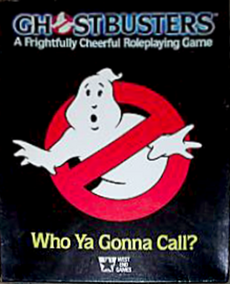Ghostbusters RPG
| Ghostbusters: A Frightfully Cheerful Role-Playing Game | ||
|---|---|---|
 |
||
| RPG published by West End Games |
||
| Rule System | Original (precursor to D6 System) | |
| Authors | Sandy Petersen Lynn Willis Greg Stafford |
|
| First Publication | 1986 (Ghostbusters: A Frightfully Cheerful Role-Playing Game) 1989 (Ghostbusters International) |
|
Ghostbusters: A Frightfully Cheerful Role-Playing Game and Ghostbusters International ‒ colloquially and collectively called simply the Ghostbusters RPG ‒ are comedy/horror roleplaying games published by West End Games. The initial title was a shameless cash-in of the first movie, with Ghostbusters International helping suck in more cash following the second movie. Despite this, they were pretty darned good, and the system used was a precursor to the D6 System later used in many titles, including the Star Wars RPG and the financially semi-fail Masterbook series.
System
Deliciously simple, the Ghostbusters RPG system used 4 basic Traits, Brains, Muscles, Moves, and Cool. To create a character, simply spread 12 points over those four Traits, with 1 as a minimum number. For normal characters, five is the highest any of those can be at character creation, but that's not a hard limit, and isn't imposed on NPCs or the pregenerated characters (see next section).
To perform an action, a player rolls as many six-siders as the character has in the relevant Trait and tries to beat a number set depending on the difficulty of the task. Woah, hold on there. One of those dice has to be the Ghost Die, which doesn't have a 6, it has a nifty ghost symbol. If that side comes up, the player is screwed; it's a Bad Thing, and whether the roll makes it or not, Shit Happens. Conversely, when a GM rolls a ghost, it works in the favour of the ghosts. Raw deal, players.
Each of the four Traits gets a Talent, like a skill that's associated with the trait. If it's relevant to the roll (like if Venkman is making a Moves roll to trick some hottie into bed with him, his Seduce Talent is absolutely relevant) then 3 more dice get thrown in the pool.
Setting
The basic premise of the setting is that the original Ghostbusters, particularly Peter Venkman and Louis Tully, love to make money, and can see great potential in screwing over small groups of people that want to run Ghostbusters franchises all over the world. Enter the players. The deal goes that the parent corporation will provide the hapless players with equipment and all that jazz, and in exchange will get a cut of the fees they charge. The Ghostbusters franchise will generally find its own customers (or, more accurately, the customers will find them) but the parent corporation can also step in and make the 'Busters do a mission for free while they rake in the monies. This is amongst numerous powers to shit on the local franchise that the parent corporation has. It's arguable that this game can be played to have more bureaucracy than Paranoia, also by West End Games, and comes with numerous photocopyable forms to get the players to sign, just like in Paranoia. Unique between the two, though, is that the Ghostbusters RPG has a Last Will and Testament for the players. Creepy, huh?
If that all sounds like too much, or the players really don't have any imagination for generating original concepts, they can play the original Ghostbusters or Louis Tully or Janine Melnitz or Dana Barrett. Truthfully, those characters are probably better used as NPCs by the Ghostmaster.
Whoever they play, the setting's baddies aren't limited to ghosts. The full range of cheesy B-movie monsters are available and encouraged, so the 'Busters might be facing off against vampires or creatures from the Black Lagoon or aliens, despite how thematically incompatible that would be with the original movies. While the Real Ghostbusters cartoon series isn't treated as part of the game's history, many of the concepts and storylines used in it would fit right in with the writing style of the RPG. No given GM has to give in to using those elements, of course, but the followup supplemental adventures really jumped the shark with things like Hot Rods of the Gods, an adventure about teenage aliens that felt like it was intended for a completely different game.